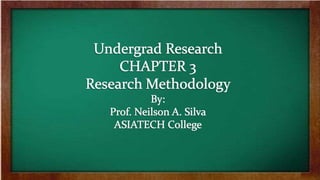Chapter 3 research methodology
•
83 likes•82,497 views
Research Methodology
Report
Share
Report
Share

Recommended
More Related Content
What's hot
What's hot (20)
How to make research paper chapter 5: Summary, Consclusion and Recommentation

How to make research paper chapter 5: Summary, Consclusion and Recommentation
Qualitative Research Chapter 3 g11 Research Method and Procedures

Qualitative Research Chapter 3 g11 Research Method and Procedures
Kabanata 1 sa pananaliksik (suliranin at kaligiran)

Kabanata 1 sa pananaliksik (suliranin at kaligiran)
Research or Proposal Writing - DEFINITION OF TERMS

Research or Proposal Writing - DEFINITION OF TERMS
Viewers also liked
Viewers also liked (17)
Statistical tests for data involving quantitative data

Statistical tests for data involving quantitative data
Similar to Chapter 3 research methodology
Similar to Chapter 3 research methodology (20)
Research Methodology - Research Design & Sample Design

Research Methodology - Research Design & Sample Design
Sampling Techniques literture-Dr. Yasser Mohammed Hassanain Elsayed.pptx

Sampling Techniques literture-Dr. Yasser Mohammed Hassanain Elsayed.pptx
More from Neilson Silva
More from Neilson Silva (10)
Recently uploaded
https://app.box.com/s/x7vf0j7xaxl2hlczxm3ny497y4yto33i80 ĐỀ THI THỬ TUYỂN SINH TIẾNG ANH VÀO 10 SỞ GD – ĐT THÀNH PHỐ HỒ CHÍ MINH NĂ...

80 ĐỀ THI THỬ TUYỂN SINH TIẾNG ANH VÀO 10 SỞ GD – ĐT THÀNH PHỐ HỒ CHÍ MINH NĂ...Nguyen Thanh Tu Collection
Recently uploaded (20)
Jual Obat Aborsi Hongkong ( Asli No.1 ) 085657271886 Obat Penggugur Kandungan...

Jual Obat Aborsi Hongkong ( Asli No.1 ) 085657271886 Obat Penggugur Kandungan...
General Principles of Intellectual Property: Concepts of Intellectual Proper...

General Principles of Intellectual Property: Concepts of Intellectual Proper...
Interdisciplinary_Insights_Data_Collection_Methods.pptx

Interdisciplinary_Insights_Data_Collection_Methods.pptx
Python Notes for mca i year students osmania university.docx

Python Notes for mca i year students osmania university.docx
80 ĐỀ THI THỬ TUYỂN SINH TIẾNG ANH VÀO 10 SỞ GD – ĐT THÀNH PHỐ HỒ CHÍ MINH NĂ...

80 ĐỀ THI THỬ TUYỂN SINH TIẾNG ANH VÀO 10 SỞ GD – ĐT THÀNH PHỐ HỒ CHÍ MINH NĂ...
Unit 3 Emotional Intelligence and Spiritual Intelligence.pdf

Unit 3 Emotional Intelligence and Spiritual Intelligence.pdf
Chapter 3 research methodology
- 2. Chapter 3 Research Methodology • Research Design • Respondents of the study • Research Instrument • Data Gathering Procedure • Treatment of Data
- 3. Chapter 3 Research Methodology Writing Chapter 3: Methods and Procedure Begin the chapter with a brief explanation of what the chapter is all about. The common introductory explanation is as follows: Writing the Introductory Paragraph This chapter presents the discussion on the research methodology of the study, the subjects, sampling technique, research instruments, procedure of data gathering, and statistical treatment that will be used for accurate data analysis and interpretation
- 4. Research Methodology This section specifies what method of research will be used – descriptive, correlation, experimental, or documentary analysis. Subjects/Respondents of the Study • A distinction should be made between subjects and respondents of the study. Subjects are persons investigated in the study. When learning abilities of pre-school pupils are being assessed in the study, the pre-school pupils are the subjects. The pupils’ teachers and mothers who will be interviewed and asked to fill out a questionnaire are the respondents of the study. Respondents, therefore, are providers of information needed in the study, elicited orally or in writing. • It is important to state your number of subjects or respondents and who they are. Also, explain how the number will be decided upon.
- 6. Simple Random Sample – SRS Technically, a simple random sample is a set of n objects in a population of N objects where all possible samples are equally likely to happen. Here’s a basic example of how to get a simple random sample: put 100 numbered bingo balls into a bowl (this is the population N). Select 10 balls from the bowl without looking (this is your sample n). Note that it’s important not to look as you could (unknowingly) bias the sample. While the “lottery bowl” method can work fine for smaller populations, in reality you’ll be dealing with much larger populations.
- 7. Sample Illustration of SRS
- 8. Stratified Sampling Stratified Sampling is possible when it makes sense to partition the population into groups based on a factor that may influence the variable that is being measured. These groups are then called strata. An individual group is called a stratum. With stratified sampling one should: • partition the population into groups (strata) • obtain a simple random sample from each group (stratum) • collect data on each sampling unit that was randomly sampled from each group (stratum)
- 10. Purposive Sampling A purposive sample is a non-probability sample that is selected based on characteristics of a population and the objective of the study. Purposive sampling is also known as judgmental, selective, or subjective sampling
- 11. Purposive Sampling Population Illustration
- 12. Sampling Technique Explain what sampling technique will be used – random, purposive, stratified, etc.—why you used it, and what procedure will be followed to carry out the technique. Research Instruments • It is necessary to have a separate discussion for this, if several research instruments have been utilized in the study. Research instruments are questionnaires, tests, interviews, observations, etc.
- 13. Data Gathering Procedure • Identify your sources of data. If a questionnaire will be used, explain what kind and how it will be constructed if it is original, how it is pre- tested, distribution, retrieval, collation, etc. Thus, your procedures may include: Construction of the questionnaire, Validation, Distribution, Retrieval, Collation, Presentation of Data and Interpretation of Data.
- 14. Statistical Treatment of Data • Specify the statistical treatment/s you will use for interpreting your data and why they are necessary. Also, include the scale or verbal interpretation for the statistical processing of your data; mention the name of the office or agency, or the person taking charge of it.
